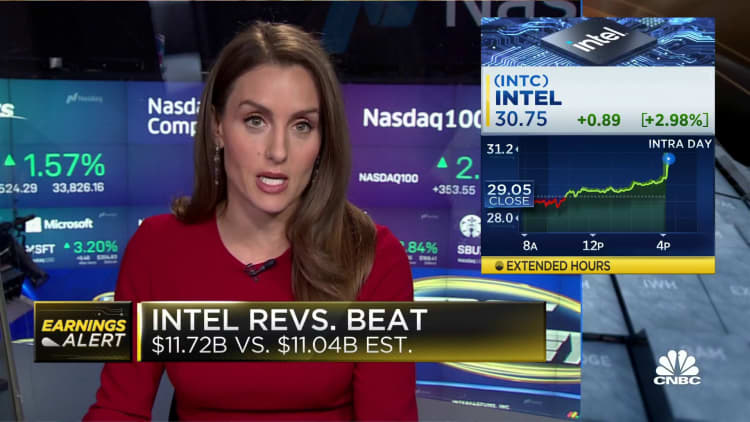Intel CEO Pat Gelsinger, with U.S. President Joe Biden (not pictured), announces the tech firm’s plan to build a $20 billion plant in Ohio, from the South Court Auditorium on the White House campus in Washington, January 21, 2022.
Jonathan Ernst | Reuters
Intel reported first-quarter results on Wednesday that showed a staggering 133% annual reduction in earnings per share. Revenue dropped nearly 36% year-over-year to $11.7 billion.
Still, the loss per share and sales were slightly better than soft Wall Street expectations. The stock fluctuated in extended trading after initially rising on the report.
Here’s how Intel did versus Refinitiv consensus expectations:
- Loss per share: Loss of $0.04 per share, adjusted, versus a loss of 15 cents per share expected
- Revenue: $11.7 billion, adjusted, versus $11.04 billion expected
Intel’s guidance for the current quarter of about $12 billion in revenue and a 4 cent loss per share came up short versus analyst expectations of $0.01 in earnings per share on $11.75 billion in sales.
Intel recorded a net loss of $2.8 billion, compared with a profit of $8.1 billion last year. GAAP revenue decreased to $11.7 billion from $18.4 billion. It’s the fifth consecutive quarter of falling sales for the semiconductor giant and the second consecutive quarter of losses.
It’s also the largest quarterly Intel loss of all time, beating out the fourth quarter of 2017, where Intel reported a loss of $687 million.

Intel reports adjusted earnings and revenue, excluding a bunch of items including inventory restructuring, a recent change to employee stock options, and other acquisition-related charges.
As CEO Patrick Gelsinger enters his third year at the helm of the company that put “silicon” in “Silicon Valley,” investors are wondering if Intel has bottomed out. The stock is up over 9% so far in 2023, but down over 35% since this time last year.
Gelsinger’s turnaround plan when he took over was to open up Intel’s factories as foundries, or factories that can make chips for other companies. Intel hopes that by 2026 that it can manufacture chips as advanced as those made by TSMC in Taiwan, and it can compete for custom work like Apple’s A-series chips in iPhones. Intel said on Thursday it was still on track to hit that goal.
“We still have more work to do as we reestablish process, product, and cost leadership, but we continue to provide proof points each quarter,” Gelsinger said on an earnings call.
But in the meantime, a business that used to print money is struggling, especially in PC chips, which used to be the company’s strongest product line. Global PC shipments dropped nearly 30% in the first quarter, according to an estimate from IDC, as the entire industry is mired in a slump.
Intel’s Client Computing group, which includes the chips that power the majority of desktop and laptop Windows PCs, reported $5.8 billion in revenue, down 38% on an annual basis.
“We are seeing increasing stability in the PC market with inventory corrections largely proceeding as we had expected,” Gelsinger said on the call, signaling that the PC market may be reaching a bottom.
Intel’s server chip division, under its Data Center and AI segment suffered an even worse decline, decreasing 39% to $3.7 billion.
“Server and networking markets have yet to reach their bottoms as cloud and enterprise remain weak,” Gelsinger said.
Its smallest full line of business, Network and Edge, posted $1.5 billion in sales, down 30% from the same time last year.
One bright spot was Mobileye, which went public last year but is still controlled by Intel. Mobileye makes systems and software for self-driving cars, and reported 16% sales growth to $458 million.
Intel also said that its recent push to cut costs, including through layoffs, was working, and that it expected to save about $3 billion in 2023 and as much as $10 billion per year by 2025.
Investors were glad to see Intel’s expanding gross margins, which the company said would be about 37.5% on a non-GAAP basis in the current quarter, which beat FactSet estimates. Intel said it was a sign that the company was strongly controlling costs and operating efficiently.
“Maybe the best way to describe it is I think for the back half of the year, we feel like we’ll be comfortably in the 40s from a gross margin perspective,” Intel CFO David Zinsner said on the call.






